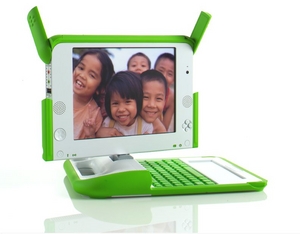The OLPC Wiki: Difference between revisions
(→About One Laptop per Child: added link to core principles) |
(→What's new: Build 386) |
||
| Line 3: | Line 3: | ||
__NOTOC__ |
__NOTOC__ |
||
==What's new== |
==What's new== |
||
* A new stable build, [http://olpc.download.redhat.com/olpc/streams/development/ |
* A '''new''' new stable build, [http://olpc.download.redhat.com/olpc/streams/development/build368/ '''Build 368'''], along with a new firmware release, [[OLPC_Firmware_Q2B85|'''Q2B85''']], are now available. Please [[Autoreinstallation_image|update your machines]]—you'll find many improvements in virtually all system functions. Release notes coming momentarily. |
||
* The B2 machines have arrived in Cambridge and are being distributed to developers who have joined the [[Developers Program]]. Those without machines can still run [[OS images for emulation|emulators]] on their current computers. If you have a machine, please see the [[BTest-2_Release_Notes|BTest-2 Release Notes]] and [[B1-demo-notes|B1 Demo Notes]]. |
* The B2 machines have arrived in Cambridge and are being distributed to developers who have joined the [[Developers Program]]. Those without machines can still run [[OS images for emulation|emulators]] on their current computers. If you have a machine, please see the [[BTest-2_Release_Notes|BTest-2 Release Notes]] and [[B1-demo-notes|B1 Demo Notes]]. |
||
Revision as of 21:18, 31 March 2007
| english | عربي | پښتو | български | deutsch | español | français | kreyòl ayisyen | italiano | 日本語 | 한국어 | монгол | Bahasa Melayu | नेपाली | norsk | português | română | русский | kinyarwanda | türkçe | 中文 | 繁體中文 | HowTo [ID# 30533] +/- |
What's new
- A new new stable build, Build 368, along with a new firmware release, Q2B85, are now available. Please update your machines—you'll find many improvements in virtually all system functions. Release notes coming momentarily.
- The B2 machines have arrived in Cambridge and are being distributed to developers who have joined the Developers Program. Those without machines can still run emulators on their current computers. If you have a machine, please see the BTest-2 Release Notes and B1 Demo Notes.
- The specification for our security platform, Bitfrost, has been released. Comments invited!
- The One Laptop per Child (OLPC) website has a new look, thanks to the efforts of Nurun and Pentagram. See also the OLPC Foundation website. We'll be setting up the infrastructure for translation of the new site in this wiki soon.
- Rwanda commits to the "One Laptop per Child" initiative.
- Uruguay announced its participation in the OLPC project.
- B1 Release Notes can be found here and should be read carefully by anyone with a BTest system.
- OLPC wins Popular Science's Best of What's New 2006.
- IDB and OLPC formalize an agreement aimed at support mainstreaming of new approaches to digital technology in Latin American and Caribbean education.
Weekly updates can be found in Current events.
About One Laptop per Child
- It's an education project, not a laptop project.
This is the wiki for the One Laptop per Child association. The mission of this non-profit association is to develop a low-cost laptop—the "$100 Laptop"—a technology that could revolutionize how we educate the world's children. Our goal is to provide children around the world with new opportunities to explore, experiment, and express themselves.
Why do children in developing nations need laptops? Laptops are both a window and a tool: a window into the world and a tool with which to think. They are a wonderful way for all children to learn learning through independent interaction and exploration.
OLPC espouses five core principles: (1) child ownership; (2) low ages; (3) saturation; (4) connection; and (5) free and open source.
More on the Laptop (pt) (es) and OLPC's vision for learning (pt) (es).
What you'll find inside
A good place to start exploring this wiki is the One Laptop per Child page, which gives an overview of the project. There is a list of frequently asked questions (FAQ); a place to ask a question; and numerous pages on hardware, software, content, and the developers program—and a separate wiki for software development. Sugar is a novel interface with its own interface guidelines. There are also discussion pages on issues of deployment and country-specific discussions. An extended table of contents is also available. The latest build is always available here. The latest stable build is always available here.
About this wiki
The purpose of this wiki is to both share information about the project and to solicit ideas and feedback. The articles and discussion vary from technical to epistemological. We invite comments on every page (please use the "discussion" tab at the top of each page). Please restrict edits to the article pages themselves to facts, not opinions. You are encouraged to sign your work and to make liberal use of citations and links. (Please make an account and please use ~~~~ as a signature for your comments.) Please note that pages that include the {{OLPC}} template—such as this one—are maintained by the OLPC team and are generally representative of the current state of the project. Other pages—created and maintained by the public—should be read with that in mind.
